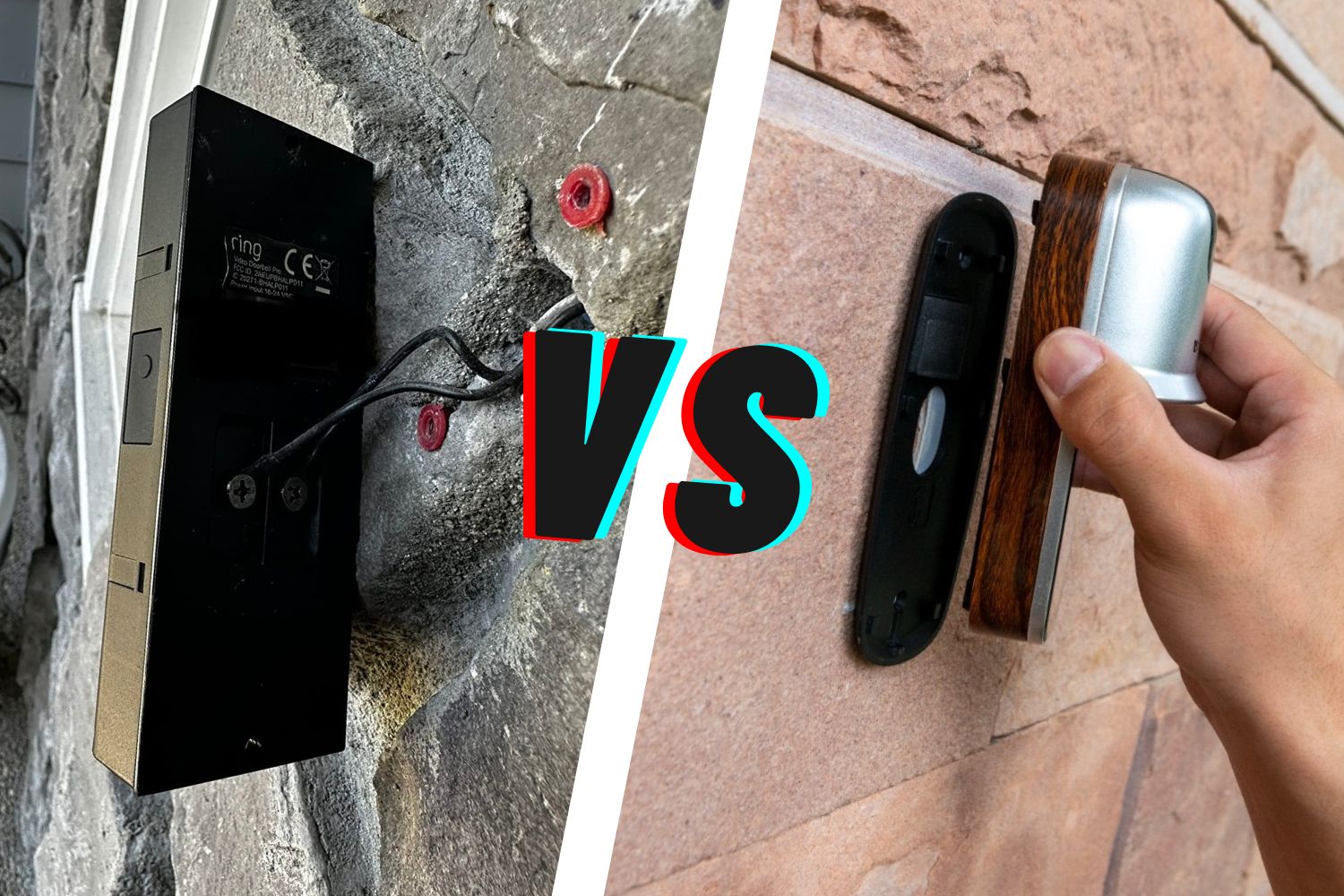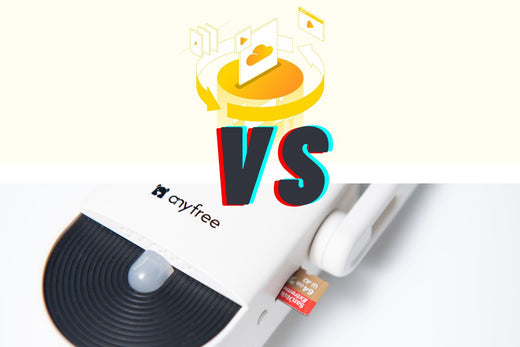When it comes to protecting your home, a smart video doorbell is one of the most effective tools you can invest in. Not only does it allow you to see who's at your door, but it also provides an extra layer of security by alerting you to any unusual activity. Whether you're at home or away, a smart doorbell can help you monitor visitors, deter potential intruders, and even communicate with delivery personnel without ever opening the door.

But with so many options on the market, how do you decide which smart video doorbell is right for you? Two of the most common types are wired and wireless doorbell cameras. Both offer similar functionalities, but the way they operate and their installation process can differ significantly.
When choosing a smart video doorbell, there are a few key factors to consider. First, think about the installation process: are you ready to deal with wiring, or would you prefer a simpler, more flexible option? Next, consider the power source—do you want a continuous supply of power, or are you okay with periodically charging a battery? Finally, reliability and video quality are crucial. You'll want a doorbell that provides clear, high-definition video, especially when it comes to identifying potential threats or visitors.
In this blog, we’ll compare wired and wireless doorbell cameras to help you understand the pros and cons of each, so you can make the best choice for your home security needs.
Wired Doorbell Cameras:
A wired doorbell camera is directly connected to your home’s existing doorbell wiring, providing a steady and reliable source of power. This type of system uses the electrical wiring that already runs to your doorbell to keep the device powered, so you won’t need to worry about charging batteries or replacing them periodically. Once installed, the doorbell camera can stream high-definition video, detect motion, and even send alerts to your smartphone.

How It Works:
Wired doorbell cameras typically work by tapping into the existing doorbell circuit, which provides them with a constant flow of power. This means they’re always on and ready to record or send alerts when motion is detected. The video feed is sent to your device through your home’s wired internet or Wi-Fi network, depending on the specific model. Some wired doorbell cameras also have a physical chime, allowing you to hear the doorbell’s sound in the traditional way, in addition to receiving digital notifications.
Pros & Cons of Wired Doorbell Cameras
Pros
Continuous Power Supply: One of the biggest advantages of a wired doorbell camera is that it is powered by your home’s electrical system. This eliminates the need for frequent charging or worrying about battery life, ensuring the camera is always functional.
More Stable Connection: Since wired doorbells don’t rely on Wi-Fi for power, they often provide a more stable and reliable connection. This means fewer interruptions in service, clearer video quality, and less chance of losing the signal, even if your home’s Wi-Fi network experiences issues.
Low Maintenance After Installation: Once a wired doorbell camera is installed, there are minimal maintenance requirements. Since it’s hardwired into the system, you won’t have to worry about charging batteries or dealing with frequent issues related to wireless connectivity. The maintenance costs are generally lower in the long run.
Cons
Complex and Costly Installation: One downside of wired doorbell cameras is the installation process. If your home doesn’t already have an existing doorbell or the wiring isn’t up to code, you may need a professional to handle the installation, which can be more expensive and time-consuming than installing a wireless option. This complexity often comes with a higher upfront cost.
Limited Flexibility: Once a wired doorbell camera is installed, it’s not as easy to move it to a different location. The camera has to be positioned where the existing wiring is available, which can limit your options if you decide to change the doorbell’s placement later on. If you move homes or want to rearrange the camera’s location, the process can be cumbersome and expensive.
Dependence on Stable Power Supply: While a wired doorbell is always powered, it is reliant on a steady electricity supply. If there’s a power outage, the camera may stop working until the power is restored. This makes wired doorbell cameras less ideal for homes in areas prone to frequent power disruptions.
Wireless Doorbell Cameras:
Wireless doorbell cameras are an increasingly popular option for homeowners looking for a simple, flexible, and hassle-free security solution. Unlike wired models, these doorbell cameras operate on Wi-Fi and are powered by rechargeable batteries, meaning they don’t need any physical wiring to function.

How It Works:
Wireless doorbell cameras work by connecting to your home’s Wi-Fi network. When someone presses the doorbell or motion is detected, the camera activates and sends a live video feed to your smartphone, tablet, or other devices. Some models also offer two-way audio, allowing you to communicate with visitors directly through the camera. Since they are powered by batteries, these cameras don't require any wiring, which makes installation much easier and more flexible.
Pros & Cons of Wireless Doorbell Cameras:
Pros
Easy Installation: One of the most significant advantages of wireless doorbell cameras is their easy installation. You don’t need to worry about existing doorbell wiring or hiring a professional to set it up. With simple mounting, these cameras can be placed wherever there’s a Wi-Fi connection, allowing for a quick and DIY-friendly installation process.
Higher Flexibility: Wireless doorbell cameras offer far more flexibility in terms of placement compared to wired models. As long as the location is within range of your home’s Wi-Fi network, you can install the camera virtually anywhere. This makes them ideal for renters or people who like to rearrange their home security setup without the need for complicated rewiring.
No Damage to Your Home: Since wireless cameras don’t require any physical connections, you don’t have to worry about drilling holes into your walls or damaging your home’s existing wiring. This makes them an excellent choice for those who want to maintain the aesthetics and integrity of their home, or for renters who are not allowed to alter the structure.
Cons
Limited by Wi-Fi Range and Quality: Wireless doorbell cameras rely entirely on your Wi-Fi connection for functionality. If your Wi-Fi signal is weak or unstable in the area where the camera is installed, it can cause performance issues, such as delays in notifications or poor video quality. To avoid this, make sure the camera is placed within a strong Wi-Fi range, or consider using a Wi-Fi extender for better coverage.
Fortunately, the anyfree Hello Doorbell tackles this issue with Wi-Fi-Halow technology, offering faster, more stable data transmission while using less power. This ensures improved performance compared to traditional wireless systems.
Requires Regular Charging: While wireless doorbell cameras eliminate the need for wiring, they do require regular battery recharging. Depending on the model and how often it’s used, this could mean charging the camera every few weeks or months. If forgotten, this can lead to lapses in security.
The anyfree Hello Doorbell, however, is equipped with a built-in solar panel that absorbs nearby sunlight—and even LED light—to recharge the battery. This significantly extends its battery life and reduces the need for frequent charging, providing a more hassle-free solution.
Possible Delays in Notifications and Video Data: Because wireless doorbell cameras rely on Wi-Fi to transmit data, there may be occasional delays in receiving notifications or accessing video footage. This can be especially problematic if you need real-time alerts for security reasons. Additionally, if your Wi-Fi is overloaded or slow, it may affect the timeliness of alerts or video streaming.
How to Choose Between Wired and Wireless Doorbell Cameras?
When selecting a wired or wireless smart doorbell camera, consider these factors based on your needs:
1.Installation Difficulty
Wired: If you own a home and prefer a permanent security setup, a wired doorbell may be the best choice. It requires professional installation to connect to your home’s existing wiring, making it ideal if you want a more secure and stable solution without frequent changes. For example, a homeowner upgrading their existing doorbell system might prefer this.
Wireless: If you’re renting or just want a simple DIY solution, a wireless doorbell is perfect. You can install it easily without drilling holes or dealing with complex wiring. A renter in an apartment who needs to move the camera when they relocate would benefit from this flexibility.
Read related article: Protect Your Apartment: Best Wireless Doorbell for Renters

2.Power Supply
Wired: If you're looking for hassle-free, continuous power, a wired system is great. For instance, a homeowner in a suburban area with stable power supply and no plans to move would appreciate the consistent performance of a wired camera.
Wireless: If you don’t mind charging the batteries occasionally, a wireless camera works well. For example, a small business owner who only needs a camera for specific hours may prefer a wireless option since recharging every few months is manageable.

3.Flexibility
Wired: If you plan on setting up the doorbell in one fixed location and don’t anticipate moving, a wired option offers stable performance without the worry of needing to relocate it. For instance, a family who’s lived in their home for years and values a permanent setup may choose this route.
Wireless: If you're someone who moves frequently or likes changing the placement of your security cameras, a wireless camera is ideal. A young couple moving to different apartments may want the flexibility of taking their wireless doorbell with them.

4.Price
Wired: Though installation costs are higher, if you're willing to pay upfront, a wired camera can be more affordable in the long term, as you won’t need to worry about charging or battery replacement. A family with a stable home and no plans to move might see the value in investing in a wired camera.
Wireless: For those on a tighter budget or renters who don’t want to invest in professional installation, a wireless option is the more economical choice. A person in a rental who values lower upfront costs and flexibility may prefer the wireless camera despite occasional battery charging.
Conclusion
If you own a home and prefer a permanent, low-maintenance setup, a wired camera might be the best solution. However, if you’re renting or need a flexible, easy-to-install option, a wireless camera is likely the better fit. Consider your living situation, how often you move, and how much maintenance you're willing to handle when making your decision.





Leave a comment
This site is protected by hCaptcha and the hCaptcha Privacy Policy and Terms of Service apply.